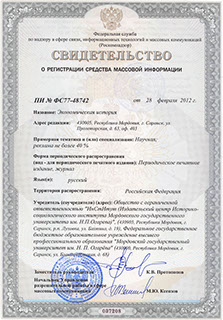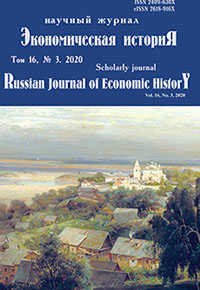Экономическая историЯ
Russian Journal of Economic History
ISSN 2409-630X (Print)
ISSN 2618-916X (Online)
Expert board:
- Scientific Council of RAS on economic history;
- Research and Educational Center «The economic history of Central Russia and the Middle Volga region» of Ogarev Mordovia State University;
- Center of Economic History of Lomonosov Moscow State University
Navigation
Certificate of registration

ISSN 2409-630X (Print), ISSN 2618-916X (Online)
DOI: 10.15507/2409-630X.050.016.202003.333-350
УДК 94:338.26.01/338.266.2«1951/1970»
Maxim A. Simonov
Institute of History and Archaeology, Ural Branch of the RAS (Ekaterinburg, Russian),
e-mail: m.a.simonov1@yandex.ru
Development of the Social Sphere of the Soviet Union based on the Materials of the General Economic Plan of the USSR for 1951–1970
Introduction. The research considers the planned trajectory of development of the social sphere of the Soviet Union in the General economic plan which was developed after the end of the World War II for the period from 1951 to 1970. Materials and Methods. The Research is based on materials from the archives of the USSR state planning Committee, the Central statistical office of the USSR, Congresses and Plenums of the Communist party. Results. The main part of the document was devoted to the creation of new heavy industries. However, to a large extent, the plan also describes building the social foundations of a Communist society: increasing the production of consumer goods, improving educational and medical services. Based on this, the General economic plan assumed the implementation of fundamental social changes that would lead to the disappearance of differences between mental and physical labor, as well as between urban and rural areas. According to the statements of the plan, the elimination of differences between mental and physical work was supposed to be achieved by further improving the level of education in society, which would eventually lead to an increase in productivity. The disappearance of the difference between urban and rural areas was considered as a gradual increase in the standard of living in the rural area to urban one, although certain differences between them should have remained at the time of the supposed victory of communism. Discussion and Conclusions. An obvious disadvantage of the General plan was that it did not take into consideration the changing needs of society in the long term and the emergence of new technologies. The analyzed General economic plan was not adopted for implementation during the life of I. V. Stalin, but this document influenced the main directions and guidelines of social policy in the second half of the 1950s and early 1960s.
Keywords: USSR; communism; late Stalinism; planning; General plan; social sphere; standard of living.
For citation : Simonov M. A. Development of the Social Sphere of the Soviet Union based on the Materials of the General Economic Plan of the USSR for 1951–1970. Ekonomicheskaya istoriya = Russian Journal of Economic History. 2020; 16(3): 333–350. (In Russ.). DOI: 10.15507/2409-630X.050.016.202003.333-350
© Ogarev Mordovia State University. History and Sociology Institute, 2017
68, Of. 411, Bolshevistskaya St., 430005, The editorial office of the scholarly journal «Russian Journal of Economic History»
Tel.: (8342) 24-25-90; 27-07-11, Fax: (8342) 24-25-90, E-mail: jurnal-econom-hist@isi.mrsu.ru
Designed by A. Napalkov, Email: napalkov@isi.mrsu.ru

